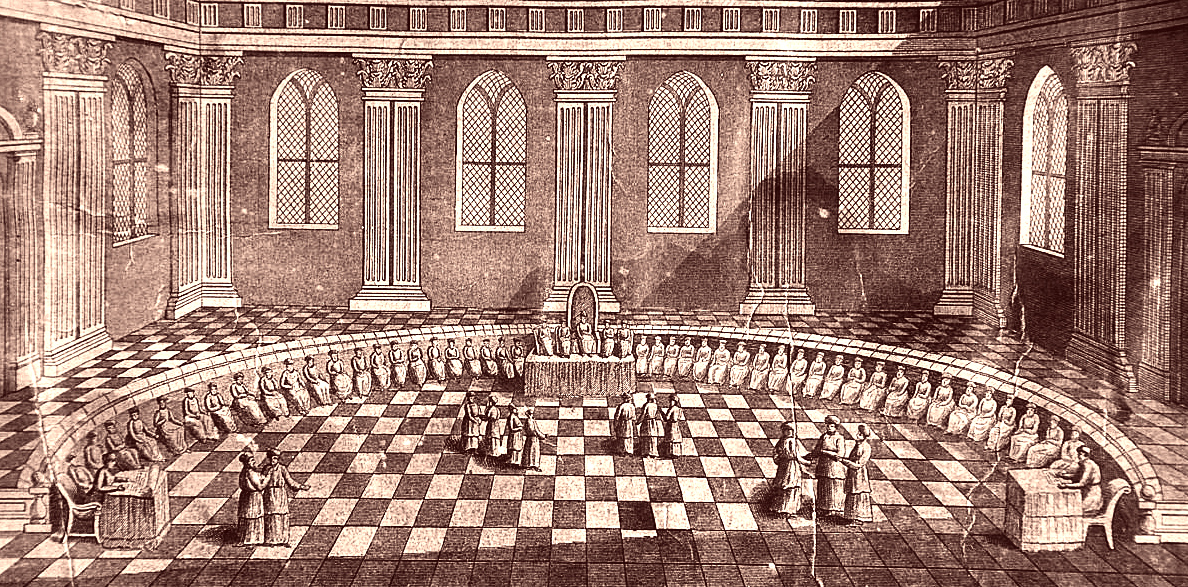Chamber Of Hewn Stone on:
[Wikipedia]
[Google]
[Amazon]
 The Hall of Hewn Stones (), also known as the Chamber of Hewn Stone, was the meeting place, or council-chamber, of the
The Hall of Hewn Stones (), also known as the Chamber of Hewn Stone, was the meeting place, or council-chamber, of the
The Sanhedrin
,
 The Hall of Hewn Stones (), also known as the Chamber of Hewn Stone, was the meeting place, or council-chamber, of the
The Hall of Hewn Stones (), also known as the Chamber of Hewn Stone, was the meeting place, or council-chamber, of the Sanhedrin
The Sanhedrin (Hebrew and Middle Aramaic , a loanword from , 'assembly,' 'sitting together,' hence ' assembly' or 'council') was a Jewish legislative and judicial assembly of either 23 or 70 elders, existing at both a local and central level i ...
during the Second Temple period
The Second Temple period or post-exilic period in Jewish history denotes the approximately 600 years (516 BCE – 70 CE) during which the Second Temple stood in the city of Jerusalem. It began with the return to Zion and subsequent reconstructio ...
(6th century BCE – 1st century CE). The Talmud
The Talmud (; ) is the central text of Rabbinic Judaism and the primary source of Jewish religious law (''halakha'') and Jewish theology. Until the advent of Haskalah#Effects, modernity, in nearly all Jewish communities, the Talmud was the cen ...
deduces that it was built into the north wall of the Temple in Jerusalem
The Temple in Jerusalem, or alternatively the Holy Temple (; , ), refers to the two religious structures that served as the central places of worship for Israelites and Jews on the modern-day Temple Mount in the Old City of Jerusalem. Accord ...
, half inside the sanctuary and half outside, with doors providing access both to the temple and to the outside. The chamber is said to have resembled a basilica
In Ancient Roman architecture, a basilica (Greek Basiliké) was a large public building with multiple functions that was typically built alongside the town's forum. The basilica was in the Latin West equivalent to a stoa in the Greek Eas ...
in appearance, having two entrances: one in the east and one in the west. Buildings in the temple complex used for ritual purposes.had to be constructed of unhewn stones. (The Torah prohibits the use of hewn stones or those touched by iron for the altar per Ex 20:22, Deut 27:6. Various reasons have been given for the prohibition, among them: the purpose of the Temple is peace, while iron implements are used in war; the Temple lengthens human life while iron shortens it; the hewing of stones is an invitation to carving images in them, violating the prohibition against idolatry
Idolatry is the worship of an idol as though it were a deity. In Abrahamic religions (namely Judaism, Samaritanism, Christianity, Islam, and the Baháʼí Faith) idolatry connotes the worship of something or someone other than the Abrahamic ...
; and the sword references the earthly power of Esau
Esau is the elder son of Isaac in the Hebrew Bible. He is mentioned in the Book of Genesis and by the minor prophet, prophets Obadiah and Malachi. The story of Jacob and Esau reflects the historical relationship between Israel and Edom, aiming ...
, not the spiritual power of Jacob/Israel.).See sources at http://etzion.org.il/vbm/english/archive/mikdash4/105mikdash.htm
According to the Talmud, the Hall of Hewn Stones is the traditional meeting place of the Great Sanhedrin
The Sanhedrin (Hebrew and Middle Aramaic , a loanword from , 'assembly,' 'sitting together,' hence ' assembly' or 'council') was a Jewish legislative and judicial assembly of either 23 or 70 elders, existing at both a local and central level i ...
when it functioned as a court with full sovereign powers including the power to impose criminal penalties.
The Sanhedrin stopped meeting in the Hall of Hewn Stones when the Roman Empire
The Roman Empire ruled the Mediterranean and much of Europe, Western Asia and North Africa. The Roman people, Romans conquered most of this during the Roman Republic, Republic, and it was ruled by emperors following Octavian's assumption of ...
restricted Judaea's autonomy and removed the Sanhedrin's power to impose criminal penalties.
Notes
References
* Schiffman, Lawrence H. ''From Text to Tradition, a History of Judaism in Second Temple and Rabbinic Times''. Jerusalem: Ktav, 1991. * Zeitlin, Solomon. ''The Rise and Fall of the Judean State: A Political, Social and Religious History of the Second Commonwealth.'' New York: Jewish Publication Society of America, 1967.The Sanhedrin
,
Aryeh Kaplan
Aryeh Moshe Eliyahu Kaplan (; October 23, 1934 – January 28, 1983) was an American Orthodox Judaism, Orthodox rabbi, author, and translator best known for his The Living Torah and Nach, Living Torah edition of the Torah and extensive Kabbalah, ...
{{DEFAULTSORT:Hall Of Hewn Stones
Temple Mount
Jewish courts and civil law
Legislative buildings
Sanhedrin